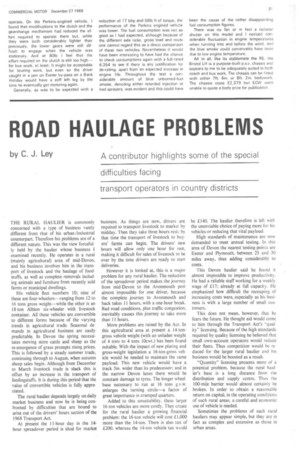ROAD HAULAGE PROBLEMS
Page 33

If you've noticed an error in this article please click here to report it so we can fix it.
A contributor highlights some of the special difficulties facing transport operators in country districts by C. J. Ley
THE RURAL HAULIER is commonly concerned with a type of business vastly different from that of his urban /industrial counterpart. Therefore his problems are of a different nature. This was the view forcefully held by the haulier whose business 1 examined recently. He operates in a rural (mainly agricultural) area of mid-Devon, and his business involves him in the transport of livestock and the haulage of foodstuffs, as well as complete removals including animals and furniture From recently sold farms or municipal dwellings.
His vehicle fleet numbers 10; nine of these are four-wheelers—ranging from 12 to 16 tons gross weight—while the other is an 18-ton Albion six-wheeler with livestock container. All these vehicles are 'convertible to different forms because of the varying trends in agricultural trade. Seasonal demands in agricultural business are easily predictable. In Devon the spring necessitates moving store cattle and sheep as the re-emergence of grass prompts rising prices. This is followed by a steady summer trade, continuing through to August, when autumn sheep sales begin. Although from December to March livestock trade is slack this is offset by an increase in the transport of feedingstuffs. It is during this period that the value of convertible vehicles is fully appreciated.
The rural haulier depends largely on daily market business and now he is being confronted by difficulties that are bound to arise out of the drivers' hours section of the 1968 Transport Act.
At present the 11-hour day in the 14hour spreadover period is ideal for market business. As things are now, drivers are required to transport livestock to market by midday. Then they take three hours rest; by that time the transport of livestock to buyers' farms can begin. The drivers' new hours will allow only one hour for rest, making it difficult for sales of livestock to be over by the time drivers are ready to start deliveries.
However it is looked at, this is a major problem for any rural haulier. The reduction of the spreaclover period makes the journey from mid-Devon to the Avonmouth port almost impossible for one driver, because the complete journey to Avonmouth and back takes 11 hours, with a one-hour break. Bad road conditions, plus traffic congestion, inevitably causes this journey to take more than 11 hours.
More problems are raised by the Act. In this agricultural area at present a 14-tongross vehicle weight (with an unladen weight of 4 tons to 4 tons lOcwt.) has been found suitable. With the impact of new plating and gross-weight legislation a 16-ton-gross vehicle would be needed to maintain the same payload. This new vehicle would have a track 5in. wider than its predecessor; and in the narrow Devon lanes there would be constant damage to tyres. The longer wheelbase necessary to run at 16 tons g.v.w. enlarges the turning circle—a factor of great importance in cramped quarters.
Added to this unsuitability, these larger 16-ton vehicles are more costly. They create for the rural haulier a growing financial problem: the 16-ton vehicle will cost £1,000 more than the 14-ton. There is also tax of £200, whereas the 14-ton vehicle tax would be £140. The haulier therefore is left with the unenviable choice of paying more for his vehicles or reducing that vital payload.
High standards of maintenance are now demanded to meet annual testing. In this area of Devon the nearest testing-points are Exeter and Plymouth, between 25 and 30 miles away, thus adding considerably to costs.
This Devon haulier said he found it almost impossible to improve productivity. He had a reliable staff working for a weekly wage of £17; already at full capacity. He emphasized how difficult the recouping of increasing costs were, especially as his business is with a large number of small customers.
This does not mean, however, that he fears the future. He thought aid would come to him through the Transport Act's -quality" licensing. Because of the high standards required by quality licensing he believed that small own-account operators would reduce their fleets. Thus competition would be re duced for the larger rural haulier and his business would be boosted as a result.
"Quantity" licensing presents more of a potential problem, because the rural haulier's base is a long distance from the distribution and supply centre. Thus the 100-mile barrier would almost certainly be broken. In order to obtain a reasonable return on capital, in the operating conditions of such rural areas, a careful and economic use of vehicle is needed.
Sometimes the problems of such rural hauliers may appear simple, but they are in fact as complex and extensive as those in urban areas.












































































